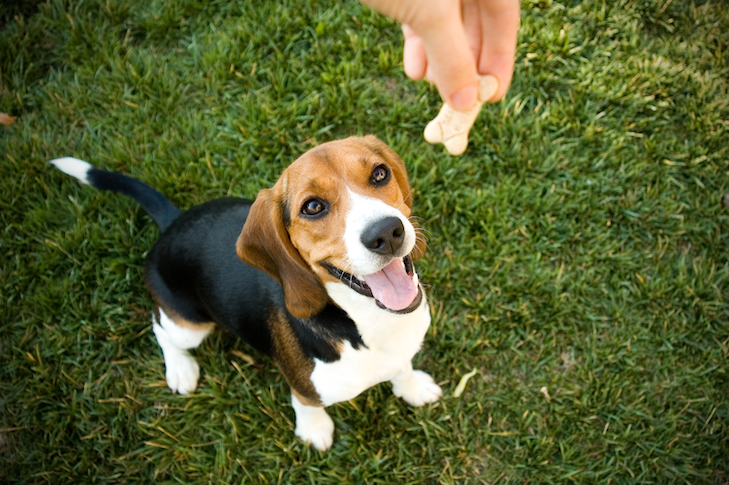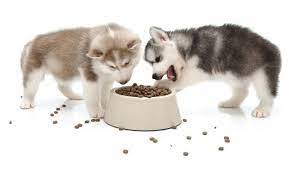How and What should I feed my puppy?
Before you pick your puppy up from the breeder or rescue centre, ask them what brand and type of food your puppy is being fed on. By the time puppies are eight weeks old, they should have been weaned from mum and be eating solid food. A reputable breeder or rescue should give you a few days’ supply of this food to take home with you when you take your puppy home (if your puppy is not weaned on to solid food, walk away and do not buy your puppy from them).
You can choose to keep them on this same puppy food, or switch them to a different brand of puppy food once they’ve settled in.
If changing your puppy to a different type or brand of food, you’ll need to do this over a week to 10 days to avoid causing an upset tummy. On the first day of the switch, add a small amount of their new food to their current food, and then slowly introduce more of the new food and less of the current food over time.
If you’re moving from a wet to a dry food, note that your puppy will likely drink more.
There is a bewildering choice of dog food available in pet shops, supermarkets and from your vet, so it can be hard to decide which is best for your puppy. Any commercial puppy food, appropriate for the age and size of your dog and described as ‘complete’, will be nutritionally balanced for your dog and won’t need to be mixed with anything else.
Your puppy should have access to fresh water at all times.
When and how often should I feed my puppy?
From when you bring your puppy home at eight weeks until they are four months old, it’s best to feed them four meals a day. At four months, reduce this to three meals a day and when they turn six months, reduce to two meals. Continue a morning and evening meal for your pup’s life.
When you choose to feed your pup their meals is up to you, but we recommend spacing out meals evenly throughout the day. Remaining consistent will help get them into a routine, which will make life easier for you and them. We also recommend avoiding strenuous exercise after eating, which can lead to vomiting and potentially bloat.
You may have read that people should always eat their dinner before the family pet gets theirs – this comes from a very outdated concept of dog behaviour and is based on the now-debunked idea that you need to show your dog who is boss (sometimes called the ‘pack leader’ or ‘alpha’). While it is important to teach your dog good manners around food so they are well-behaved and don’t eat things that could cause them harm, your puppy isn’t planning a household takeover! What’s more important to a puppy is routine and consistency, as this will ensure they understand what you expect of them and grow into a confident dog who trusts you. Feeding your pet at the same time each day will help get them into a routine, and ensuring everyone in the family consistently sticks to any doggy rules you decide upon (for eg no titbits from the table) will help your pup to understand what you’re asking of them more quickly.
Where should I feed my puppy?
Find a quiet spot where your pup can chow down in peace and won’t be disturbed by other pets, children or adults. We recommend feeding your new puppy away from any other household pets until they’re all used to each other and won’t be tempted to pinch each other’s dinner!
Does my puppy need ‘puppy’ food?
Puppies have growing bodies and so have different nutritional needs to fully grown dogs. We recommend feeding your pup a labelled puppy food until they are around a year old (or as advised by your vet) before moving them on to an adult food. Your vet may recommend feeding a large or giant breed puppy food for longer than a year.
Help! My puppy is a quick eater
Some dogs just love their food and will hoover it up in no time at all. If your pup is one of them, it’s a good idea to invest in a way of slowing them down. This could be through stuffing their meal into a Kong so they have to eat it slowly, or using a puzzle bowl which makes it trickier to get to the food in as quick a time and so slows them down.
Some breeds (usually large or giant breed dogs) are more susceptible to a condition called bloat, where the stomach fills with gas and flips, cutting of the blood supply. It’s a very serious and potentially life-threatening illness and veterinary attention should be sought immediately. Bloat can be brought on by eating too quickly, so for these breeds in particular we recommend using a slow feeding bowl.
How to know if your puppy is fat
Pet obesity is a huge problem in the UK, with studies suggesting that 56 per cent of the nation’s dogs are overweight or obese. Fat dogs will struggle more to enjoy life and the likelihood of them suffering from serious conditions such as diabetes, heart disease, breathing problems and cancer, is increased. These health problems won’t just put a strain on your wallet as they are costly to treat, but they could cause heartache too as each tends to lead to premature death. They are also at greater risk of arthritis, which is painful for dogs. Managing your pup’s food intake alongside suitable exercise for their age is the best way to prevent them getting fat.
Many dog owners don’t recognise that their pet is overweight, but there are simple and easy ways to check. Look straight down at your pup’s body from above. Your pet’s waist should taper in to give an hourglass shape. If they look oval from above you will need to think about cutting down on their food intake, and if the hourglass shape is too extreme they are underweight.
Gently run your hands along both sides of your dog’s chest and you should be able to feel their ribs through a thin layer of fat. The ribs should not be highly visible as they would be in an emaciated dog, but neither should it be difficult to feel them through a layer of fat




